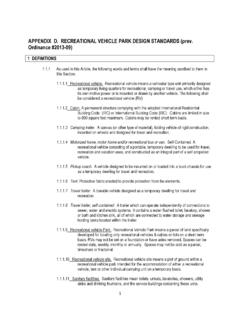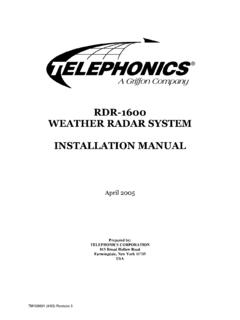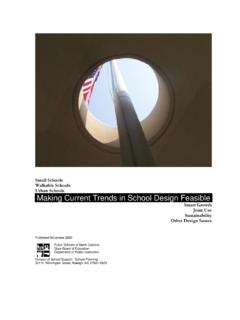Transcription of Risk to Groundwater - SSWM
1 GUIDELINESFORA ssessingthe Riskto Groundwaterfrom On-SiteSanitation BRITISH GEOLOGICAL SURVEY COMMISSIONED REPORT CR/01/142 Guidelines for Assessing the Risk to Groundwater from On-Site Sanitation A R Lawrence, D M J Macdonald British Geological Survey, UK A G Howard1, M H Barrett, S Pedley Robens Centre for Public and Environmental Health, UK (1 presently with Water, Engineering and Development Centre, UK) K M Ahmed University of Dhaka, Bangladesh M Nalubega Key words Groundwater , water supply, sanitation, boreholes, wells, springs, risk assessment, monitoring, guidelines Bibliographical reference ARGOSS 2001. Guidelines for assessing the risk to Groundwater from on-site sanitation. British Geological Survey Commissioned Report, CR/01/142.
2 97pp. NERC 2001 British Geological Survey 2001 Makerere University, UgandaThe full range of Survey publications is available from the BGS Sales Desks at Nottingham and Edinburgh; see contact details below or shop online at The London Information Office maintains a reference collection of BGS publications including maps for consultation. The Survey publishes an annual catalogue of its maps and other publications; this catalogue is available from any of the BGS Sales Desks. The British Geological Survey carries out the geological survey of Great Britain and Northern Ireland (the latter as an agency service for the government of Northern Ireland), and of the surrounding continental shelf, as well as its basic research projects.
3 It also undertakes programmes of British technical aid in geology in developing countries as arranged by the Department for International Development and other agencies. The British Geological Survey is a component body of the Natural Environment Research Council. Keyworth, Nottingham NG12 5GG +44 115-936 3241 Fax +44 115-936 3488 e-mail: Shop online at: Murchison House, West Mains Road, Edinburgh EH9 3LA +44 131-667 1000 Fax +44 131-668 2683 e-mail: London Information Office at the Natural History Museum (Earth Galleries), Exhibition Road, South Kensington, London SW7 2DE +44 20-7589 4090 Fax +44 20-7584 8270 +44 20-7942 5344/45 email: Forde House, Park Five Business Centre, Harrier Way, Sowton, Exeter, Devon E 2 7HU +44 1392-445271 Fax +44 1392-445371 Geological Survey of Northern Ireland, 20 College Gardens, Belfast BT9 6BS +44 28-9066 6595 Fax +44 28-9066 2835 Maclean Building, Crowmarsh Gifford, Wallingford, Oxfordshire O 10 8BB +44 1491-838800 Fax +44 1491-692345 Parent Body Natural Environment Research Council, Polaris House, North Star Avenue, Swindon, Wiltshire SN2 1EU +44 1793-411500 Fax +44 1793-411501 BRITISH GEOLOGICAL SURVEY 1: BACKGROUND AND supply and sanitation Health Water quality problems and contamination Types of sanitation and their potential Groundwater Risk.
4 Importance of Aquifer vulnerability to pollution and risks to Groundwater Hydrogeological Unconsolidated aquifers Consolidated sedimentary Weathered basement Sources of Other sources of faecal Contaminants associated with on-site Attenuation of contaminants in the Attenuation of microbiological Definition of risk categories for microbiological contamination via aquifer Attenuation of chemical Pathways for localised Design and construction of Groundwater Sanitary protection measures at headworks39 ContentsPART 2: THE GUIDELINES4. First-step risk Assessing the risk of microbiological contamination of Groundwater supplies via aquifer Installation of Groundwater supplies where on-site sanitation already exists, or in combinationwith the installation of on-site Installing on-site sanitation alone, where Groundwater supplies already Assessing the risk of nitrate contamination of Groundwater supplies as a result of widespread aquifer Assessing the risk of microbiological contamination due to pathways created by construction of the Groundwater supply565.
5 Ongoing assessment of risk through Why monitor? Monitoring to provide confidence in Monitoring to establish cause of Health-based surveillance Monitoring to evaluate trends in water quality and How to When and where to monitor? Data analysis and Localised versus widespread Widespread microbiological contamination Widespread chemical contamination Localised microbiological contamination participation in monitoring75 References and further reading78 Glossary80 Appendix A - Worked examples84 Appendix B - Full page versions of selected graphs90 Appendix C - Sanitary inspection Principal elements of faecal oral disease Examples of on-site sanitation Typical Groundwater supply The source pathway receptor Natural and man-made pollution pathways to Groundwater The Groundwater flow Illustration of types of voids within Thick sediments associated with rivers and coastal Mountain valley Minor
6 Sediments associated with Weathered bedrock Sources of faecal pollution within urban and rural settings Attenuation processes within the unsaturated and saturated Pathogen diameters compared with aquifer matrix Pathways for contamination into Groundwater Sanitary protection measures for springs and Flowchart for assessing the risk of microbiological contamination of Groundwater supplies via aquifer Attenuation mechanisms within unsaturated Grain sizes of a range of sediment Attenuation with depth below Travel time for the flow to a borehole screen from the water-table for a range of pumping rates and screen depths, and a series of aquifer porosities and Kh:Kv Increased lateral separation between pollution source and Groundwater supply reduces Flow chart for assessing the risk of microbiological contamination of Groundwater supplies via aquifer pathways where Groundwater supplies exist and only on-site sanitation is being Flow chart for assessing the risk of nitrate contamination of Groundwater supplies as a result of widespread aquifer Simplified relationship between average annual rainfall and Groundwater recharge Estimated nitrate concentration in Groundwater recharge based on population density and average annual recharge Where boreholes are deep.
7 The onset of high nitrate concentrations will be significantly delayed due to the time taken for the front of high nitrate waters to reach the borehole Flow chart for assessing the risk of microbiological contamination due to pathways created by construction of the Groundwater Flow chart for monitoring of Groundwater Correlation of nitrate and chloride concentrations in Groundwater beneath Santa Cruz, Flow chart for identifying the appropriate response to localised contamination of Groundwater suppliesGUIDELINES FOR ASSESSING THE RISK TO Groundwater FROM ON-SITE SANITATION2 Index of figures and Advantages and disadvantages of different sanitation systems Typical permeability values for various rock Aquifer vulnerability subdivided into four broad classes Principal hydrogeological environments and their associated pollution Illnesses acquired by ingestion of faecally contaminated Sanitary protection measures required for different Pathways and indirect factors influencing contamination of Groundwater Characteristics of hydrogeological environments relevant to risk assessment
8 Hydraulic loading associated with on-site sanitation Assessment of risk following attenuation of micro-organisms within the unsaturated Typical aquifer properties for a range of rock types and feasibility of using horizontal Percentage of potential nitrate in Groundwater recharge likely to leach from a pit latrine to the water-table in a range of hydrogeological Potential for time-delay in the onset of nitrate problems Key criteria for headworks Parameters to monitor, equipment needed and requirements for A comparison of field and laboratory analysis of Broad guidance on the frequency of Elements to check when re-evaluating the first-step risk assessment Approximate travel times in various aquifer systems to indicate likely times before onset of chemical Percent frequency of reporting from an assessment of springs in a town in south-west Percent frequency of reporting of sanitary risk factors against water quality categories from boreholesin two towns in Uganda GUIDELINES FOR ASSESSING THE RISK TO Groundwater FROM ON-SITE SANITATION3 GUIDELINES FOR ASSESSING THE RISK TO Groundwater FROM ON-SITE SANITATION4 ForewordThere has been encouraging progress with
9 Access to safe drinking water and sanitation in both rural andurban areas since the United Nations Water Decade of the 1980s. However, more than 1 billion peoplearound the world still lack access to safe water supplies and more than billion are without adequatesanitation. A substantial majority of these people live in Asia where the lack of sanitation provision isparticularly acute. In Africa, over one third of the population still remains without access to safe water andsanitation, and many of these can only be served by Groundwater . The need for renewed efforts toimprove the situation is recognised in DFID s recently published water strategy paper "Addressing theWater Crisis - Healthier and More Productive Lives for Poor People".
10 The health benefits of safe water supply are only properly realised when programmes combine safe watersupply with sanitation and the promotion of safe hygiene practice. With increasing population, thepressure on land in all cities is becoming intense. High levels of pollution are increasing the risk togroundwater from sanitation and drainage facilities. These guidelines are an important contribution to risk assessment and the avoidance of the contaminationof Groundwater supplies from on-site sanitation. They have been developed as part of a project funded byDFID through the water component of the Infrastructure and Urban Development Division s Knowledgeand Research Programme. Ian CurtisSenior Water Resources AdviserDepartment for International Development, UKAcknowledgements5 AcknowledgementsThe authors would like to thank those who have contributed both directly and indirectly to theproduction of this manual:The staff of the following organisations who have been involved with the field-testing of the manualBangladesh: Department of Public Health Engineering of the Government of Bangladesh, Terre Des Hommes, WaterAid, the World Health Organisation and UNICEFU ganda: Action Contre Faim, Ruwasa, WaterAidThose individuals who provided detailed reviews of the document including Stephen Foster (BGS), JeremyOckelford (Consultant Engineering Advisor to DFID)











